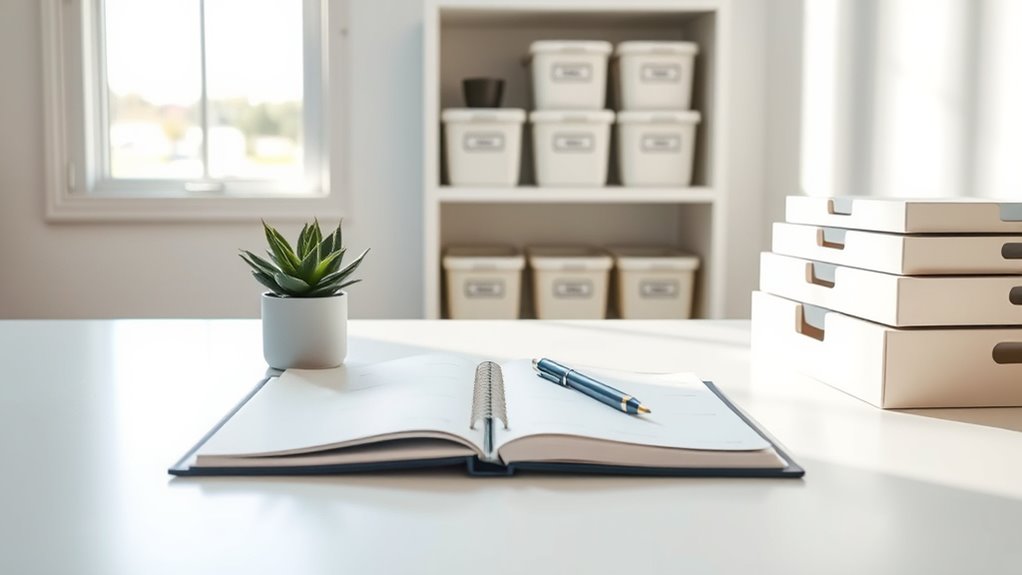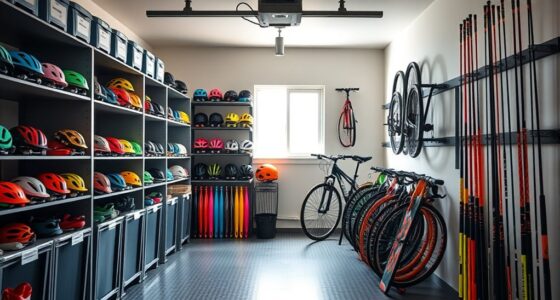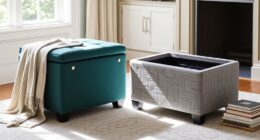When I'm looking to maintain a tidy life, two essential decluttering picks I swear by are time-efficient strategies and practical organization tools. I prioritize short 10-15 minute sessions focused on one area at a time. This way, I see progress without feeling overwhelmed. Alongside that, I love using multi-functional furniture and vertical storage to maximize my space. Stick with me, and I'll share more tips to simplify your decluttering journey and keep your home organized!
Key Takeaways
- Command-Z Solution: This method simplifies decision-making by allowing you to quickly assess whether to keep or discard items, reducing clutter stress.
- 10-15 Minute Time Blocks: Busy individuals can dedicate short, focused sessions to decluttering, making it manageable and less overwhelming.
- Multi-Functional Furniture: Investing in furniture that serves multiple purposes helps maximize space and reduce the number of items needed in a home.
- Checklists and To-Do Lists: Utilizing these tools enhances focus and organization, ensuring that decluttering tasks are manageable and prioritized.
- Rewards for Progress: Incorporating small rewards for completing decluttering tasks keeps motivation high and makes the process enjoyable.
Decluttering Workbook: The Essential Guide to Organize and Declutter Your Home and Life
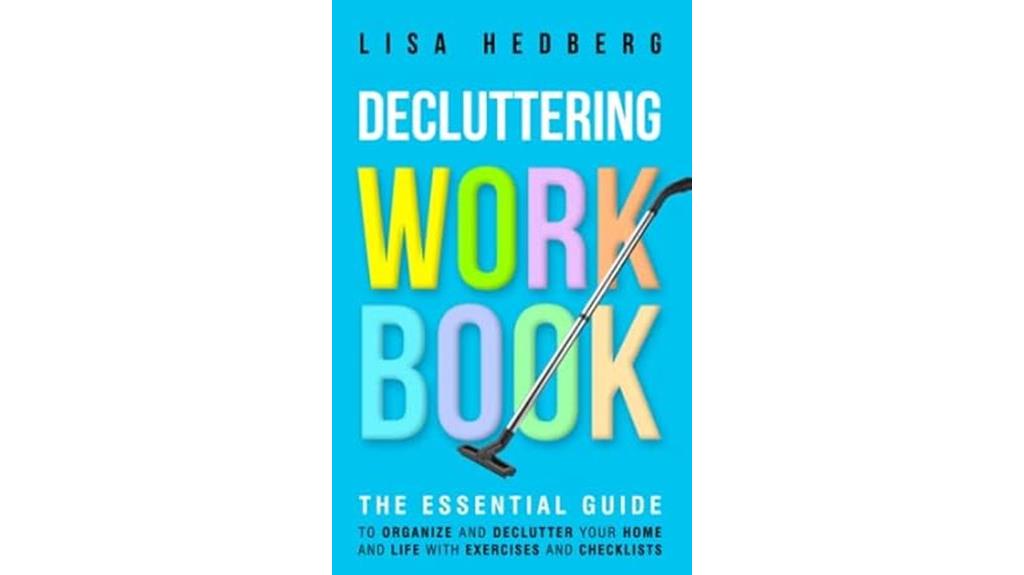
If you're someone who's constantly juggling a busy schedule but still feels overwhelmed by clutter, Lisa Hedberg's *Decluttering Workbook* is tailored just for you. This guide transformed my approach to organization. It's not just about tidying up; it's about making decluttering a lifestyle. The workbook's exercises are manageable, asking for just 10-15 minutes of my time. I appreciated how it focuses on understanding my clutter triggers instead of just tackling the mess. With practical, empathetic advice and built-in rewards, I found myself not only organizing my space but also changing my habits for good. It's truly a game-changer!
Best For: Individuals struggling with clutter who seek practical, manageable steps to integrate decluttering into their lifestyle.
Pros:
- Offers a conversational tone and empathetic advice, making it relatable and approachable for those feeling overwhelmed.
- Includes practical exercises that can be completed in short time frames, encouraging consistency and habit formation.
- Provides additional resources such as downloadable materials and an audiobook version for flexible learning.
Cons:
- Some readers may find the emphasis on self-reflection and inner work to be less actionable than straightforward organizing tips.
- The workbook's approach may not resonate with those looking for quick, immediate fixes rather than a lifestyle change.
- The exercises require personal commitment and motivation, which might be challenging for some individuals.
Decluttering Advice: Easy Ways to Reduce Stress and Declutter Your Home

For busy individuals juggling work, family, and social commitments, "Decluttering Tips for Busy People" offers practical strategies that fit seamlessly into a hectic lifestyle. I found that tackling one room at a time and creating to-do lists made decluttering manageable. Lisa Hedberg's book helped me understand my emotional attachments to items, allowing me to let go of what no longer serves me. The Command-Z Solution made decisions easier, reducing my stress. While the format could use more bullet points for quick reference, the supportive tone and actionable advice empower me to maintain a tidy, organized home amidst my busy life.
Best For: Individuals seeking to simplify their lives and reduce clutter in a manageable way while addressing emotional attachments to belongings.
Pros:
- Offers practical strategies that fit into busy lifestyles, making decluttering less overwhelming.
- Provides a supportive tone and actionable advice, empowering readers to maintain an organized home.
- Introduces techniques like the Command-Z Solution to simplify decision-making regarding what to keep or discard.
Cons:
- The format may lack bullet points and visual aids for quicker reference, which some readers may prefer.
- The narrative style can be more detailed than some individuals looking for rapid solutions might want.
- Emotional introspection required may not resonate with everyone, potentially making some feel overwhelmed.
Factors to Consider When Choosing Decluttering Picks Busy People Can't Live Without
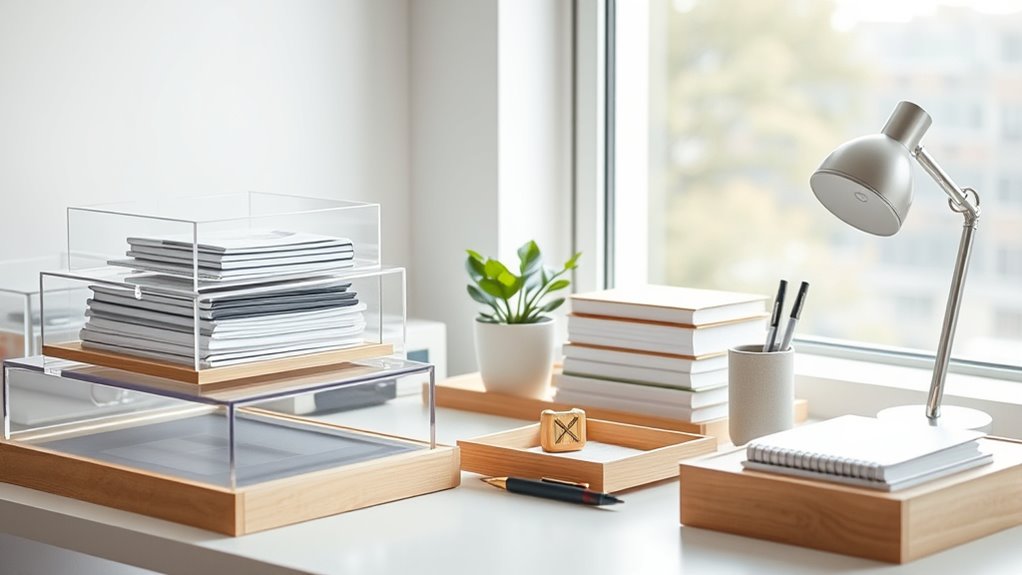
When I think about decluttering, I focus on what really makes a difference for busy lives like ours. It's crucial to reflect on time efficiency, practical tools, and our emotional ties to items. By honing in on these factors, I can simplify my decision-making and create sustainable habits that stick.
Time Efficiency Strategies
Although life can feel hectic, finding efficient ways to declutter can make a big difference. I've learned that allocating short time blocks of 10-15 minutes for decluttering helps me stay focused without feeling overwhelmed. Prioritizing one room or area at a time allows me to see tangible progress, which keeps me motivated. I've also found that creating to-do lists or using techniques like the Command-Z Solution enhances my decision-making on what to keep or toss. To stay committed, I incorporate little rewards for completing tasks, making the process enjoyable. Finally, reflecting on emotional attachments and asking myself questions before new purchases helps prevent future clutter, ultimately saving me time down the line.
Practical Organization Tools
Choosing the right organization tools can make a world of difference in your decluttering journey. I've found that tools prioritizing efficiency are essential for managing my busy life. Start by tackling one area at a time; it keeps things manageable. Incorporating checklists and to-do lists helps me stay focused, ensuring I don't overlook any tasks. I'm also a fan of tools with built-in rewards, like progress trackers, which keep me motivated. For storage, I suggest using multi-functional furniture or vertical options to maximize space without taking too much time. These practical tools not only streamline my decluttering process but also make it easier to maintain order in my home. You'll find they can be a game changer, just like they were for me!
Emotional Attachment Considerations
While it's easy to get caught up in the sentimental value of our belongings, I've learned that recognizing emotional attachments is essential for effective decluttering. Many of us cling to items because of memories or guilt, especially when those items are gifts. By reflecting on why we hold onto certain things, I've found it easier to let go of what no longer serves me. Asking myself questions about the value and utility of each item helps me clear out clutter without feeling overwhelmed. It's liberating to give myself permission to discard items that don't contribute positively to my life. Understanding the psychological toll of clutter, like increased anxiety, has motivated me to prioritize my mental well-being and embrace a clearer living space.
Simplified Decision-Making Techniques
How can busy people make quick and effective decluttering decisions? I've found that using simplified decision-making techniques really helps. For instance, the Command-Z Solution allows me to evaluate items based on their current usefulness instead of clinging to emotional attachments. Setting a strict 10-15 minute timer for decluttering sessions keeps me focused and prevents overwhelm. I also stick to a "one in, one out" rule—this guarantees I remove an old item whenever I bring in a new one. Creating a simple checklist for each room helps me stay organized and tackle specific tasks. Finally, I reflect on my past purchases by asking what purpose they serve, which makes my decisions about what to keep or discard much clearer.
Sustainable Decluttering Habits
To maintain sustainable decluttering habits, I focus on integrating small, consistent actions into my daily routine. I dedicate just 10-15 minutes each day to tackle a specific area. This gradual approach keeps me from feeling overwhelmed. I also work on identifying and changing my bad habits, like procrastination, which helps me address the root causes of clutter. Journaling about my emotional attachments to items lets me make informed decisions on what to keep or let go. I set up seasonal reviews of my possessions to confirm I'm continuously evaluating what I own. Finally, I've developed the habit of questioning the necessity of new purchases, promoting mindfulness and supporting a minimalist lifestyle.
Frequently Asked Questions
How Long Does It Take to See Results From Decluttering?
I've found that seeing results from decluttering can happen pretty quickly, often within a few hours if I focus on a specific area. When I tackle just one room or even a single drawer, I notice an immediate difference. However, for long-term change, it takes consistent effort over weeks or months. The key is to stay motivated and celebrate small victories, which keeps me going and helps maintain the tidy space I've created.
What Are the Best Storage Solutions for Small Spaces?
When it comes to cozy spaces, I've found that clever storage solutions can work wonders. I love using under-bed storage bins for seasonal clothes and stacking organizers in closets. Floating shelves transform walls into functional art, while multi-purpose furniture, like ottomans with hidden compartments, keeps things tidy. Don't forget about over-the-door hooks; they're a game changer! With a little creativity, even the tiniest nook can become a haven of organization.
Can Decluttering Improve Mental Health?
Absolutely, decluttering can markedly improve mental health. I've experienced it firsthand. When I clear out unnecessary items, I feel a sense of relief and accomplishment. My mind becomes less cluttered, allowing me to focus better and reduce anxiety. It's like creating a fresh start in my space, which translates to a fresh start in my mind. Trust me, embracing minimalism has made a notable difference in my overall well-being. Give it a try!
How Do I Motivate Myself to Start Decluttering?
I find that setting small, achievable goals really helps me get started with decluttering. I often pick one area, like a drawer or a shelf, and commit to just 15 minutes. It's amazing how quickly I see progress, which keeps me motivated. I also remind myself of how great it feels to have a tidy space. If I can see the benefits, I'm more likely to keep going!
What Should I Do With Items I No Longer Need?
When I find items I no longer need, I usually decide between donating, selling, or recycling them. If they're in good condition, I'll donate them to local charities or shelters. For things with resale value, I list them online or at a garage sale. If something's broken or unusable, I recycle it to minimize waste. This way, I feel like I'm giving items a new life while clearing my space.
Conclusion
In my own journey, I stumbled upon two decluttering picks that transformed my chaotic space into a haven of calm. Coincidentally, they not only saved me time but also eased the emotional burden of letting go. By embracing these tools, I discovered that decluttering isn't just about tidying up; it's about creating a life that feels lighter and more focused. If you're busy like me, give these essentials a try—they might just change your perspective on organization!
